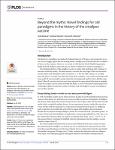Beyond the myths: Novel findings for old paradigms in the history of the smallpox vaccine
Esparza, José
Nitsche, Andreas
Damaso, Clarissa R.
The discovery of smallpox vaccination by Edward Jenner in 1796 gave a new perspective to science in the struggle against this devastating disease. Smallpox has claimed hundreds of millions of lives over the centuries. However, it was only in 1980 that the World Health Organization finally declared smallpox eradicated after an intense worldwide vaccination campaign [1].
The intriguing history of the smallpox vaccine is replete with mythology that continues to fascinate researchers today. The main mystery concerns the true origin of the vaccine matter used by Jenner and subsequent early vaccinators [2, 3]. For the 20th century, we certainly know the answer: vaccinia virus. But what of previous centuries—was cowpox or horsepox the virus used? Or was it actually vaccinia virus that was being used, and if so, how did this come about? After all, vaccinia virus has never been reported to cause natural infections in animals, except for escapee vaccine strains in Brazil and India [4]. Next-Generation Sequencing (NGS) technologies applied to genomic studies of modern and old smallpox vaccines are helping to sort out these puzzles.
Dateien zu dieser Publikation

